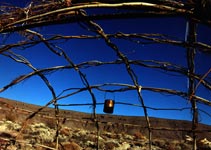Mayor, environmentalists declare victory of people power over nuclear power
 Sarnia Mayor Mike BradleyAs reported by the Sarnia Observer, the Mayor of Sarnia, Ontario, Canada, Mike Bradley (photo, left), has declared victory in a years-long campaign to block the shipment of radioactive steam generators, by boat on the Great Lakes, from Bruce Nuclear Generating Station in Kincardine, Ontario, across the Pacific, to Sweden.
Sarnia Mayor Mike BradleyAs reported by the Sarnia Observer, the Mayor of Sarnia, Ontario, Canada, Mike Bradley (photo, left), has declared victory in a years-long campaign to block the shipment of radioactive steam generators, by boat on the Great Lakes, from Bruce Nuclear Generating Station in Kincardine, Ontario, across the Pacific, to Sweden.
“It's a real testament to citizen power,” said Bradley, who has been a vocal critic of the move, along with a growing list of Ontario mayors, coalition groups, environmental activists, and U.S. Senators. “We're fighting a very large and powerful organization.”
First Nations, including the Mohawks, as well as hundreds of municipalities in Quebec representing millions of citizens along the targeted shipment route, made the difference for the resistance.
Kay Cumbow, the nuclear power watchdog in Michigan who first discovered the risky shipping scheme through her research, then warned and activated others, has said "Thanks to everyone who wrote letters, signed petitions and helped get the word out about the dangers of this scheme that would have put the Great Lakes at risk, endangered workers as well as communities enroute, and would have put radioactive materials into the global recycled metal supply."
Maude Barlow, national chairwoman of the Council of Canadians, was quoted by the Ottawa Citizen: "This is a huge victory for communities around the Great Lakes...The Great Lakes belong to everyone and communities have a right to say 'no' to any projects that will harm them."
As indicated by Mayor Bradley in a separate Sarnia Observer article, the next big fight against "nuclear madness" brewing at Bruce involves proposals by Ontario Power Generation, the Canadian Nuclear Waste Management Organization, and the Canadian Nuclear Safety Commission to bury all of Ontario's so-called "low" and "intermediate" level radioactive wastes -- from 20 atomic reactors across the province -- within a mile of the Lake Huron shoreline. Several communities near Bruce, largely populated by Bruce nuclear workers and in effect company towns, have also volunteered to be considered for a national Canadian high-level radioactive waste dump (for 22 reactors). Ojibwe First Nations, whose land the Bruce Nuclear site is built upon, have expressed grave concerns about the proposed DUDs.





 July 29, 2013
July 29, 2013

